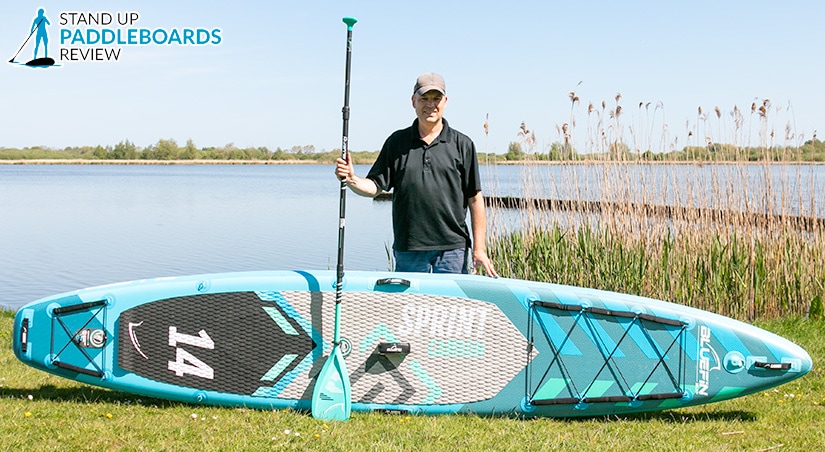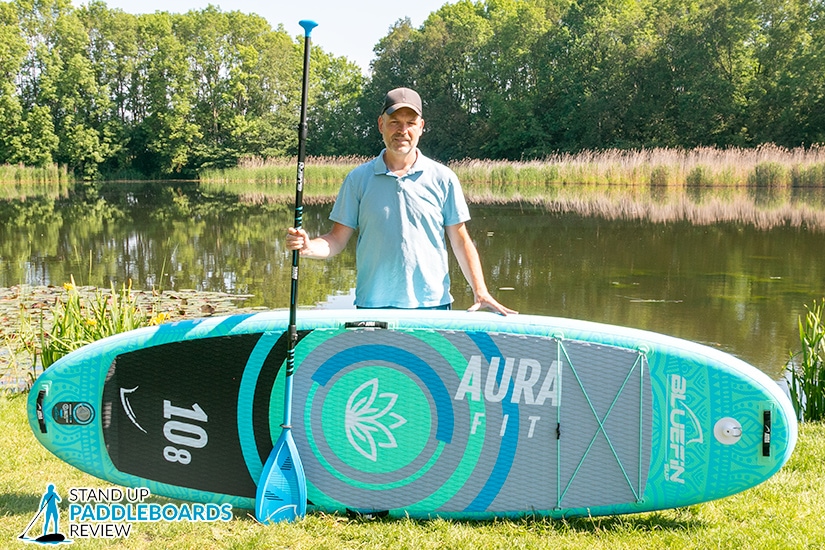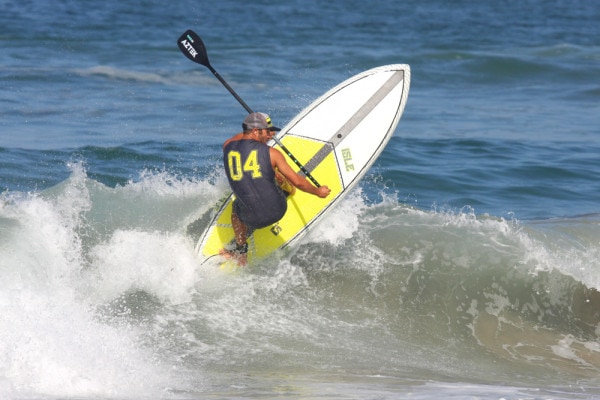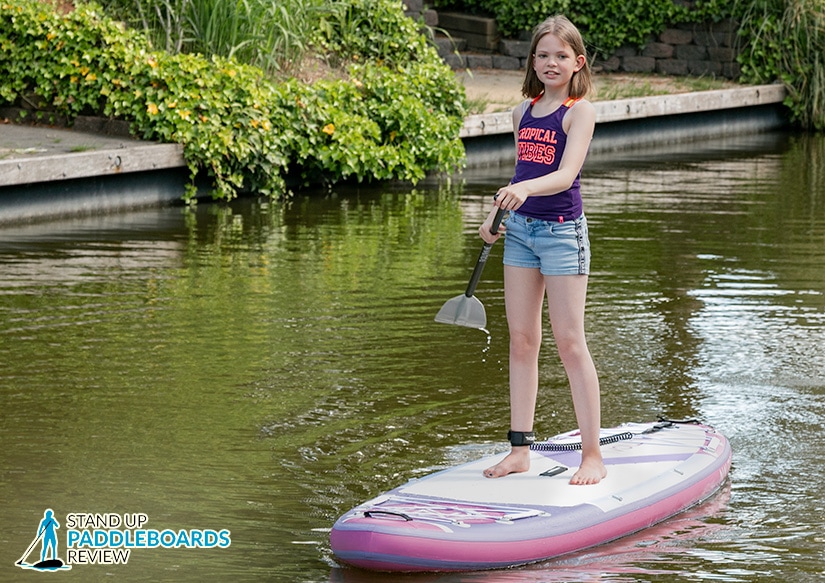So, you’re considering getting into paddle boarding? Awesome! Paddle boarding is a fantastic way to increase fitness, connect with nature, and enjoy time on the water. But with so many options available, how do you know which type of board is best for beginners? Fear not, because I’m here to help!
In this article, I’ll discuss the different types of paddleboards for beginners, talk about paddle board size and construction, and give you our recommendation on the best paddle boards for beginners. So let’s dive in.
Key Takeaways
- a variety of paddle board types cater to different activities and skill levels
- size, stability, and construction impact performance and enjoyment
- for beginners, I recommend an inflatable paddleboard with a length of 10’6″ to 11’6″ and a width of 32″ to 34″
Inflatable vs. Solid Paddle Boards
The first consideration for beginners buying a paddle board is choosing between inflatable and solid options. Let’s look at the pros and cons of each.
Inflatable Paddle Boards
Inflatable paddle boards, also known as inflatable SUPs, have become increasingly popular in recent years, especially among beginners. They are constructed from durable PVC material which, when inflated, provide a firm and stable surface for paddling.
Some benefits of inflatable paddle boards include:
- Portability: They can be deflated, making them easy to transport and store.
- Durability: High-quality inflatable SUPs are often resistant to dings and punctures.
- Stability: Inflatable SUPs generally have wider, rounder designs, making them more stable for beginners.
However, it’s worth noting that inflatable paddle boards tend to be slower and less maneuverable than solid options.
Solid Paddle Boards
Solid paddle boards are typically made from materials like foam, fiberglass, or carbon fiber, making them rigid and durable. Like their inflatable counterparts, solid paddle boards come in a variety of shapes and sizes, suited for different activities and skill levels.
Some advantages of solid paddle boards include:
- Performance: They offer improved speed, maneuverability, and responsiveness compared to inflatable SUPs.
- Variety: Solid paddle boards cater to a range of activities, including racing, touring, and surfing.
- No inflation required: Just grab your solid paddle board and hit the water!
On the other hand, solid paddle boards are bulky, making them more challenging to transport and store.
To help you with your decision, here’s a quick comparison table:
| Feature | Inflatable Paddle Board | Solid Paddle Board |
| Portability | Excellent | Poor |
| Stability | Great | Good |
| Durability | High | Moderate |
| Price | Affordable | Varies |
Unless transportation isn’t an issue or you want to get into SUP surfing (more about that later), I recommend most beginners to go for an inflatable paddleboard.
Read more about inflatable vs. solid paddleboards for beginners
Different Types of Paddle Boards
All-around SUP Boards
All-around paddle boards are typically between 10’6 and 11’6 in length, and 32” – 34” in width.
You can often recognize all-around paddle boards by their more rounded noses and tails. This shape allows them to perform well in various conditions, making them an ideal option for those who want to explore different waterways.
Considering their user-friendly design, all-around SUP boards cater to the needs of beginners but are also suitable for advanced paddlers. It is easier to find your balance as you stand up and begin to paddle, resulting in less frustration and a more enjoyable experience overall. Their versatility makes all-around paddle boards perfect for recreational use, fitness, or even yoga.
If you’re just starting with paddle boarding and want a reliable board that offers a stable and versatile performance, you should go for an all-around SUP board.
Touring or Racing SUPs
When taking up paddle boarding as a beginner, one might wonder whether to choose a touring SUP or a racing SUP. Both options have distinguishing features and benefits that can cater to different preferences.
Touring paddle boards are known for their distinctive long and sleek design, often measuring between 12’6″ and 14′ in length, and 30″- 32″ in width. Additionally, they usually have a displacement hull, allowing the nose to split the waves rather than riding above them. This design means that touring SUPs track better and offer more speed than all-around paddle boards. However, their longer and narrower structure results in less stability, making them a bit challenging for beginners.
Touring paddle boards are great if you know you’ll spend your time cruising your lake, river, or even open ocean touring.
A more extreme version of a touring SUP is a racing SUP board. Compared to touring boards, paddle boards for racing are even narrower, giving them even less drag and more speed on the water. The downside is that race SUPs are even less stable and much more difficult to stand on.
Yoga and Fitness SUP Boards
When it comes to practicing Yoga-on-Water (YOW), choosing the right stand-up paddleboard is crucial. Combining the tranquility of water with the physical benefits of yoga, YOW provides a unique and enjoyable way to stay fit. With specific paddle boards designed to cater to yoga enthusiasts, let’s explore the features that make a board suitable for beginners.
Yoga and fitness SUP boards are typically wider than regular boards, providing increased stability and balance necessary for executing various poses. A common size for yoga paddleboards ranges from 34″ to 36″ in width and 10′ to 11′ in length. This extra width ensures better performance on the water while performing yoga or Pilates, but keep in mind that these boards will not be as fast or light as other paddleboards.
Some of the main features you should look for in a yoga paddleboard include:
- Width and Length: As mentioned previously, boards designed for yoga are wider than typical paddleboards, providing essential stability and balance.
- Deck Pad: An essential factor to consider is the quality and size of the deck pad. A soft and comfortable pad allows for better grip and support while also providing cushioning for your feet, knees, and other body parts during a workout.
- Storage Space: Additional storage options, such as bungee cords or D-rings, can come in handy for securing your belongings, like your paddle, water bottle, towel, or anchor, as you practice your routine.
- Board Material: The construction of the paddle board is also important. Most people prefer an inflatable paddle board for SUP yoga for the extra stability. The slight cushioning of an inflatable SUP is also easier on the body practicing your yoga poses.
Paddle Boards for Surfing
If you want to ride the waves, a SUP surfing board is your best choice. Generally meant for intermediate and advanced paddlers, SUP surfing boards are typically shorter (max. 10′), narrower, and have a narrower nose and tail than all-around models.
Paddle boards for surfing are built for maneuverability. The downside to this is that they aren’t the most stable or fast. Unless you know that you’ll primarily be SUP surfing, this is not the type of paddle board you should purchase as a beginner.
Paddle boards for kids
Stand-up paddle boarding is a great activity for you and your children. If you know that you’ll frequently bring your children along with you when paddleboarding, consider getting a slightly larger paddle board to accommodate the extra weight.
Many children will also enjoy paddling by themselves or with friends. When they are teenagers, they can use an adult-size paddle board.
For younger children, there are special paddle boards for kids. Kids’ boards are typically between 7’6 to 9’ in length. These shorter boards are lighter, more maneuverable, and perfect for young paddlers.
Size Matters
When starting out in paddle boarding, it’s essential to find the right size board to make the learning process smooth and enjoyable. Considering factors such as length, width, volume, and board thickness can greatly impact stability and overall performance.
As mentioned above, a great starting point for beginners is an all-around, inflatable paddle board within the range of 10’6″ to 11’6″ in length, and 32″ to 34″ in width. This is a good size paddle board for beginners. These dimensions provide an optimal balance between stability and maneuverability, making it easier for novices to find their footing.
The volume of a paddle board, measured in liters, influences its buoyancy and load-carrying capacity. As a beginner, it’s best to go with a higher-volume board that can support your weight comfortably and enable you to maintain stability.
In addition to length, width, and volume, board thickness plays a vital role in determining stability. Thicker boards generally offer more buoyancy and stability, proving beneficial to learners. Typically, an all-around, inflatable paddle board has a thickness of 6″, offering a good balance for stability and performance.
Stability vs. Speed
When choosing a paddle board for beginners, it’s essential to consider the balance between stability and speed. But how do we determine which aspect should get more attention? Let’s explore some factors that play a role in each aspect.
Stability is often a priority for beginners, as it allows them to feel more comfortable on the water and focus on learning the essentials of paddle boarding. Some features that contribute to increased stability include:
- Wider boards: Boards with a width of 32-34 inches provide a larger surface to stand on, making it steadier during use.
- Larger volume: High-volume boards help to displace water evenly, keeping the board stable while carrying weight.
- More thickness: A thicker board (6 inches) ensures better buoyancy and less water interaction.
On the other hand, speed is essential for those looking to cover long distances or enhance their performance. Aspects that contribute to faster boards are:
- Narrower width: Choosing a board with a narrower width (28-30 inches) reduces drag, resulting in increased speed.
- Longer length: Longer boards (12-14 feet) offer better tracking and glide, enabling the paddler to travel more swiftly.
- Pointed nose: A pointy nose assists in cutting through water, reducing resistance and contributing to faster movement.
Understanding Paddle Board Construction
Let’s talk about the different materials and construction techniques used in paddle boards.
The two primary materials used in solid paddle board construction are carbon fiber and fiberglass. Carbon fiber offers lightweight and exceptional stiffness, making it preferred by professional riders. Fiberglass, on the other hand, is more affordable, lightweight, and durable, which makes it an excellent option for beginners.
Now, let’s get familiar with an essential technology in inflatable paddle board construction called drop-stitch technology. This technology involves connecting thousands of polyester threads between the top and bottom layers of the board. It ensures that the board maintains its shape and rigidity when inflated.
Inflatable paddle boards are made of one or more layers of high-quality PVC material. This construction makes for easy transportation, storage, and durability in various water conditions.
If you’re a beginner, fiberglass paddle boards or inflatable paddle boards offer a more cost-effective and practical choice. They provide the perfect balance of durability and performance for those starting in the SUP world.
Remember that while materials and construction are essential, selecting the right board for your skill level and water conditions will also play a significant role in your paddle boarding experience.
Additional Features to Consider
When looking for the perfect paddle board for beginners, there are several additional features to consider that can significantly impact your experience on the water. Let’s dive into these features and understand why they matter.
1. Board Shape and Weight Capacity: A wider board with a planing hull is recommended for beginners, as it provides better stability and balance. Additionally, consider a board with a higher weight capacity to ensure it can accommodate both you and any gear you plan to bring along.
2. Fins and Their Setup: Most paddle boards come with either a single fin, tri-fin, or universal fin box setup. Removable fins offer more versatility, as they can be adjusted depending on the water conditions. For instance, larger fins enhance tracking in calm waters, while smaller fins enhance turning ability in surf conditions.
3. Durability and Weight: Durability is crucial for those starting in the sport, as beginners are more prone to accidents. Look for a board made of durable materials such as PVC or heavy-duty foam. However, keep in mind that weight plays a critical role in portability, so aim for a balance between durability and lightweight construction.
4. Deck Pad and Attachment Points: A comfortable deck pad and multiple attachment points can significantly enhance your paddleboarding experience. A deck pad offers grip and comfort for SUP yoga or simply cruising, whereas attachment points come in handy for securing your gear, such as a life jacket or cooler.
| Feature | Benefit |
| Planing Hull | Provides stability and balance |
| High Capacity | Accommodates user and gear |
| Removable Fins | Versatility for different water conditions |
| Durable Material | Withstands wear and tear |
| Comfortable Deck Pad | Ideal for SUP yoga or relaxed cruising |
| Attachment Points | Secure gear and accessories |
5. Family and Dog-Friendly Options: If you plan to paddleboard with family members, including your dog, consider a board with additional attachment points and a spacious deck area. This will ensure a fun and safe experience for everyone.
6. Portability: Lastly, a beginner-friendly paddle board should be portable and easy to transport. Look for boards that can be easily deflated and packed for convenience when traveling.
Taking these additional features into account will help you find a paddle board that not only caters to your needs as a beginner but also offers an enjoyable experience on the water.
Choosing the Right Type Board for Beginners
If you’re a beginner looking to get into the exciting sport of paddle boarding, selecting the right board can make a significant difference in your experience. In order to ensure a smooth and enjoyable time on the water for novice paddlers, it’s crucial to focus on factors such as stability, width, and length when choosing a paddle board.
As I’ve said multiple times in this article, for most beginners I recommend choosing an all-around, inflatable paddle board with a length between 10’6 and 11’6 and a width of 32” to 34”. Go with a 10’6 board if you’re lighter than approx. 175 lbs. If heavier, go with an 11’ or 11’6 board.
Check out this page for several boards I recommend for beginners.






